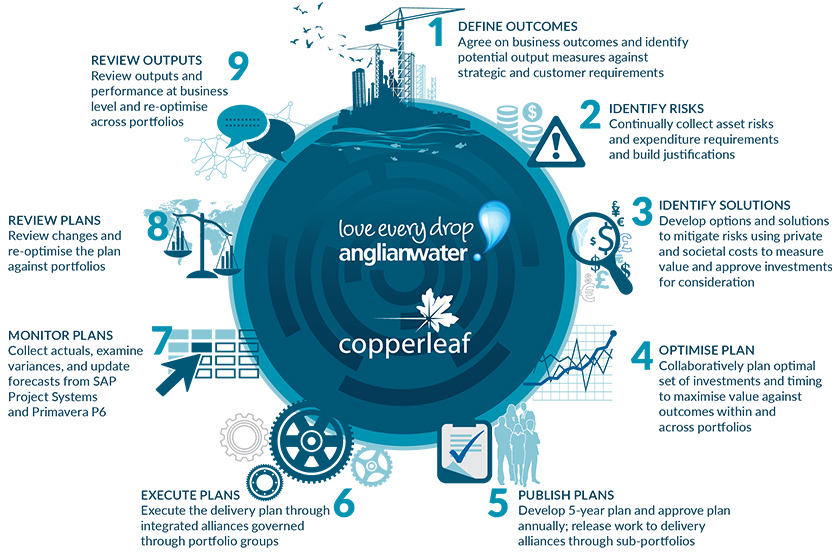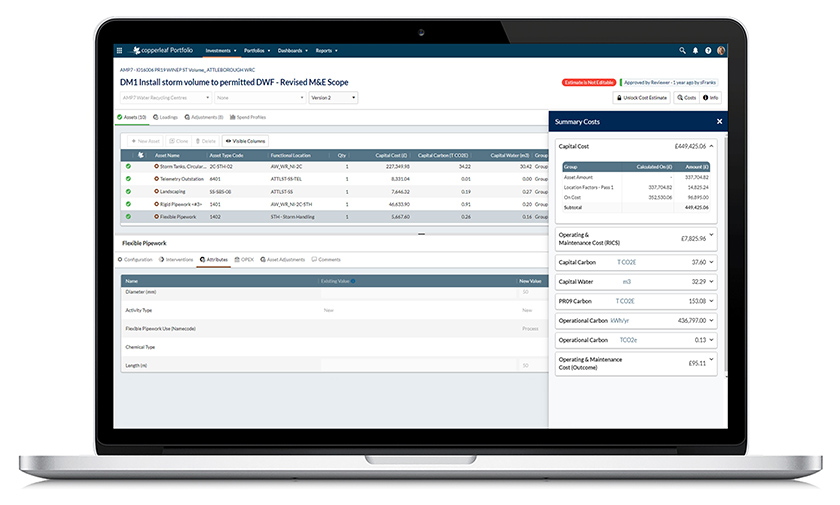Feature Article: Collaborating for Climate Resilience: The Value in Data-driven Asset Management
John Harvey, ESG Leader at Copperleaf®, discusses the importance of ESG and climate resilience considerations in asset investment planning, highlighting how Anglian Water has leveraged this approach to build resilience and create greater value for the organisation and its stakeholders. This article was originally featured in The Institute of Asset Management’s Assets magazine.
Managing ageing assets with limited resources and restricted budgets. Reducing carbon footprint while transitioning to a low-carbon economy. Balancing strategic objectives with complex constraints and targets. All these things compound the challenging environment of asset management in the face of climate change.
If you’re reading this article, then you’re no stranger to the emphasis the IAM places on asset resilience. The effects of climate change add another crucial—and urgent—layer of complexity to the process of assessing and addressing asset risk.
Incorporating Environmental, Social, and Governance (ESG) considerations into investment planning is more important than ever before, and companies that prioritise ESG considerations in their asset investment planning (AIP) benefit from improved risk management, enhanced reputation, and greater stakeholder trust.
But the potential risks and consequences mean every decision we make carries much more weight and gravity today than it did in the past. To look beyond the surface-level benefits and gain a holistic view of investment decisions and impact, organisations need an integrated, data-driven approach to create robust and defensible asset investment plans that align with both operational and ESG objectives.
Anglian Water’s challenge in a changing climate
Anglian Water provides water to almost 7 million people through a network of 40,000 km of pipes in East Anglia—one of the hottest and driest areas in the UK.
Climate change threatens the long-term sustainability of the region, causing increasing demands on its ageing water infrastructure. Increasingly frequent, and more extreme weather conditions are already causing more watermain failures, especially in areas with aggressive soil types. To improve on its climate adaptation and asset resilience strategy, Anglian Water wanted to better understand and plan for how climate change would affect its assets.
Anglian Water needed to use and continue to integrate ESG considerations into their investment planning, with particular focus on climate resilience and environmental justice. Combined with the predictive power of decision analytics, this approach has increased value (forecasted and realised) over and above the total cost of their investment plans.
Industry collaboration leads to innovation
For Anglian Water, the journey to greater sustainability involved collecting the necessary data to inform and defend their decisions.
Anglian Water partnered with MapleSky and Copperleaf to build an evidence base for tactical decision making and a long-term delivery strategy. They combined their knowledge to develop climate models that identify the watermains most vulnerable to climate change. These predictions are calculated based on each asset’s physical attributes (e.g. material, length, diameter, pressure), geological parameters (e.g. soil shrinkability class), historical burst data, and UK Climate Projection scenarios (greater chance of hotter and drier summers, warmer and wetter winters).
The detailed results from the climate models and Anglian Water’s deterioration and consequence models were incorporated into Copperleaf’s decision analytics solution. The ability to develop and compare multiple (and multi-parameter) asset strategies provided Anglian Water greater visibility on the expected increases in bursts per year (up to 2070) due to climate change, and helped identify watermains which are most at risk in the summer, this decade, and to the end of the century.
Data visualisation in Copperleaf allowed Anglian Water to identify where and when to intervene—and within business constraints like funding and resource availability—to secure the long-term climate resilience of the water network. This approach improves customer service by reducing the number and duration of supply interruptions while minimising the environmental and social impacts of repair work such as traffic disruption.
Through this approach, Anglian Water is better able to contribute to its ESG goals and serve its communities even under extreme future climates, fulfilling its purpose to bring environmental and social prosperity to the region it serves through its commitment to Love Every Drop.

Long-term perspectives enhance planning
The long-term horizon and increasing severity of climate change and its impacts are major reasons why climate-related risks are so difficult to predict.
Anglian Water contends with hot, dry summers—problematic for water provision due to less rainfall, meaning less water and increased demand. Extreme weather is also a major cause of watermain failures as it affects the soil where the infrastructure is buried. Without resilient materials and timely interventions, more bursts can be expected as summer heat and dryness become more intense with the rise of global temperatures.
After inputting and configuring the climate models, soil data, and asset attributes into Copperleaf, Anglian Water can quickly and easily calculate the probability of failure and predict future watermain bursts by year up to 2070. Anglian Water then uses this data as supporting evidence when building robust business cases to unlock funding for major capital spend required to upgrade the most vulnerable parts of the network.
Data science supports optimisation
In 2019, Anglian Water formally included public interest within the constitutional makeup of its business, committing to understanding its impact on communities and the environment, while considering business performance and returns for investors.
With a better view of data and climate models, Anglian Water can understand the expected increase in bursts per year due to climate change in future decades. This forecast allows them to optimise the timing and planning for short- and longer-term interventions, and prioritise the most important projects based on potential risks, supply interruptions, the likelihood of asset failures and so on.
Having an enterprise-wide repository of cost, carbon, and value information available in the Copperleaf solution allows Anglian Water to evaluate and quantify different risks and benefits (financial and non-financial) on a common scale. It’s through this value framework that Anglian Water can align its own strategic goals, based on the six capitals model, with ESG efforts and meeting the United Nations’ Sustainable Development Goals. In addition to doing better by its customers, Anglian Water has delivered a 61% reduction in capital carbon, and has won multiple awards for its impressive use of technology to manage its carbon footprint.

A sustainable and equitable future
Anglian Water’s approach to ESG in AIP offers several key lessons for other companies:
- It highlights the importance of collaboration between asset-intensive organisations and external partners to develop innovative solutions to complex challenges.
- Companies that take a long-term view of AIP, accounting for the potential impacts of climate change on asset performance and communities, can find opportunities to build resilience and achieve sustainability goals.
- It demonstrates the value of using data science and optimisation software to enhance investment planning decisions based on climate risk and ESJ considerations.
By prioritising climate resilience and environmental justice in AIP, companies like Anglian Water are better able to make asset investment decisions in impactful and equitable ways that support strategic goals, asset performance, and the wellbeing of the communities they serve, and the planet we share.
Learn more about our work with Anglian Water.

